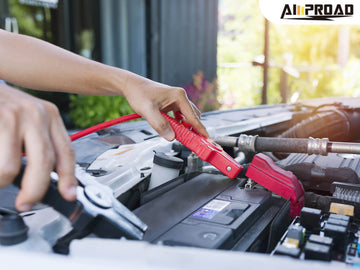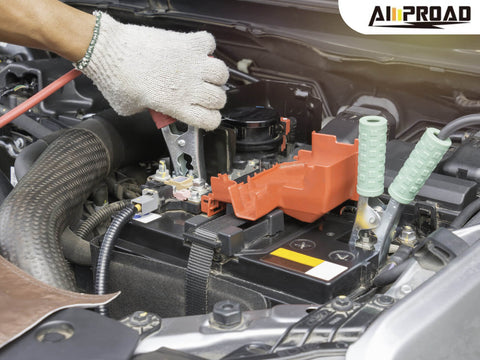
Fixing a portable jump starter at home can save time and money, but knowing where to start is crucial. Whether it's a simple connection issue or a more complex internal component failure, understanding the basics can help diagnose and potentially resolve the problem.
Is the Issue a Simple Fix?
When facing issues with your portable jump starter, it's crucial to assess whether the problem can be easily resolved with basic troubleshooting steps.
Check the Connection:
When inspecting the connection between the jump starter and the battery, it's essential to thoroughly examine the cables for any signs of looseness or damage. Check both ends of the cables to ensure they are securely attached to the jump starter and the battery terminals. If you notice any corrosion on the terminals, it's crucial to address it promptly, as it can impede the flow of electricity and affect the performance of the jump starter.
To remove car battery corrosion effectively, you can use a wire brush specifically designed for cleaning battery terminals. Gently scrub the terminals to remove any buildup of corrosion or grime. Alternatively, you can use a terminal cleaner solution to dissolve stubborn corrosion deposits. After cleaning, wipe the terminals dry with a clean cloth to ensure a clean and dry surface for optimal conductivity.
Related article: How to clean car battery corrosion?
In addition to cleaning the terminals, inspect the cables themselves for any signs of wear, fraying, or damage. Damaged cables can compromise the connection and should be replaced as soon as possible to prevent further issues. Ensure that the cables are free from any twists or kinks that could inhibit the flow of electricity.
By thoroughly inspecting and cleaning the connection between the jump starter and the battery, you can ensure a reliable and secure connection, allowing the jump starter to function effectively when needed. Regular maintenance of the connection and cables will help prolong the lifespan of your portable jump starter and minimize the risk of unexpected failures.
Low Battery:
When your jump starter fails to power on, it's often due to a depleted battery. To address this issue, start by connecting the jump starter to a power outlet using the provided AC adapter. This allows the battery booster to draw power from the electrical grid to recharge its internal battery.
Refer to the user manual accompanying your jump starter for specific instructions on the charging process. Different models may have varying charging requirements, such as voltage and charging duration, so it's essential to follow the manufacturer's guidelines carefully to ensure safe and effective charging.
Typically, the charging process for a jump starter takes several hours to complete fully. During this time, the internal battery gradually replenishes its charge, allowing the jump starter to regain its functionality. It's important to be patient and avoid interrupting the charging process prematurely, as this could result in incomplete charging and compromise the jump starter's performance when needed.
While waiting for the battery to recharge fully, you may notice indicator lights or other visual cues on the jump starter indicating the charging status. These indicators can provide valuable information about the progress of the charging process and help you determine when the battery is fully charged and ready for use.
By following these steps and allowing sufficient time for the battery to recharge fully, you can ensure that your jump starter is always ready to provide assistance whenever you need it. Regularly check the charging status and perform maintenance as recommended by the manufacturer to keep your jump starter in optimal condition for reliable performance.
By addressing potential issues related to the connection and battery, you can often troubleshoot and resolve common problems with your portable jump starter. However, if the problem persists or if you encounter more complex issues such as internal component failure, it's best to seek assistance from the manufacturer or a professional technician. Remember to prioritize safety and follow the guidelines outlined in the user manual for optimal performance and longevity of your jump starter.
Are There More Complex Issues?

When troubleshooting your portable jump starter, you may encounter more complex issues beyond simple fixes like checking connections and charging the battery. Let's explore some of these potential issues and how to address them:
Blown Fuse:
If your jump starter suddenly stops working, it could be due to a blown fuse. Many jump starters have internal fuses that can blow if the device is overloaded or experiences a power surge. To check for a blown fuse, refer to the user manual to locate its position within the device. Once found, inspect the fuse to see if the filament inside is intact or if it's broken. If the fuse is blown, you'll need to replace it with a new one. Replacement fuses can typically be found online or at electronics stores. Ensure that you use the correct type and rating of fuse as specified by the manufacturer to avoid damaging the device further.
Faulty Cables:
Another common issue with jump starters is faulty cables. Over time, the cables can become worn, frayed, or damaged, which can compromise their ability to conduct electricity safely and effectively. Inspect the cables carefully for any signs of cuts, fraying, or damage to the insulation. If you notice any issues, it's essential to replace the cables promptly to prevent safety hazards and ensure reliable performance. Many manufacturers offer replacement cables for their battery boosters, or you may be able to find compatible cables from third-party suppliers. When replacing the cables, make sure to use cables of the appropriate gauge and quality to maintain the integrity of the electrical connection.
Internal Component Failure:
If the above solutions fail to resolve the issue, it's possible that there's a more significant problem with internal components like the battery or circuit board. These components can degrade over time due to normal wear and tear or other factors, leading to malfunctions in the jump starter's operation. Repairing or replacing internal components typically requires specialized skills and knowledge of electronics repair, including soldering. If you're comfortable with electronic repair and have the necessary tools and expertise, you may be able to diagnose and fix the issue yourself. However, if you're unsure or uncomfortable with performing these repairs, it's best to seek assistance from a professional technician or contact the manufacturer for support.
To conclude, while simple fixes like checking connections and charging the battery can resolve many issues with portable jump starters, more complex issues may require further investigation and potentially professional assistance. By understanding common problems and how to address them, you can ensure that your jump starter remains reliable and ready to use when you need it most.
What are the Important Considerations?

When troubleshooting your portable jump starter and considering potential solutions, several important factors should be taken into account:
Safety First:
Before attempting any repairs or troubleshooting, always prioritize safety. Working with electrical components can be hazardous, so it's crucial to take appropriate precautions. Ensure that the car is turned off and parked in a well-ventilated area to minimize the risk of accidents or exposure to harmful fumes. Additionally, follow proper jump-starting procedures as outlined in the user manuals provided with your jump starter. These procedures are designed to ensure safe and effective operation while minimizing the risk of damage to the vehicle or injury to yourself.
How to Boost a Car:
If your jump starter fails to power on, you may need to consider how to boost a car using alternative methods. This could involve using jumper cables to connect your car's battery to another vehicle's battery to provide the necessary power to start the engine. However, it's essential to follow proper jump-starting procedures and ensure that both vehicles are turned off and parked safely before attempting the jump start.
Warranty:
If your jump starter, such as the Amproad jump starter, is still under warranty, it's important to consider the potential implications of attempting DIY repairs. In many cases, attempting repairs yourself may void the warranty provided by the manufacturer. Before proceeding with any repairs, contact Amproad or the manufacturer to inquire about warranty coverage and support options. They may be able to provide guidance or assistance in resolving the issue, either through troubleshooting steps or by arranging for repairs or replacement under warranty.
This ensures that you're aware of the warranty terms and conditions associated with your Amproad jump starter and can take appropriate action to resolve any issues while maintaining warranty coverage. By following the manufacturer's guidelines and seeking support when needed, you can address any problems with your Amproad jump starter effectively and ensure continued reliability for your vehicle's emergency power needs.
Complexity:
Finally, consider the complexity of the issue and your own level of comfort and expertise with electronics repair. If you're unsure or uncomfortable with performing repairs yourself, it's advisable to seek assistance from a professional mechanic or electronics repair shop. These professionals have the knowledge, experience, and tools necessary to diagnose and resolve complex issues safely and effectively. By entrusting the repair process to trained professionals, you can ensure that the problem is addressed properly and minimize the risk of further damage or injury.
Always Refer to the User Manual
When troubleshooting issues with your jump starter, it's essential to always refer to the user manual for detailed instructions. While general guidelines can be helpful, the user manual provides specific troubleshooting steps tailored to your car booster pack model.
The user manual contains valuable information about the operation, maintenance, and troubleshooting of your jump starter. It includes detailed diagrams, troubleshooting flowcharts, and step-by-step instructions to help you diagnose and resolve common issues.
Before attempting any troubleshooting or repairs, take the time to familiarize yourself with the contents of the user manual. Pay attention to sections related to troubleshooting, safety precautions, and maintenance procedures.
If you're unsure about any aspect of troubleshooting or if the issue persists after following the manual's instructions, don't hesitate to contact the manufacturer or seek assistance from a professional technician. They can provide further guidance and support to help resolve the issue safely and effectively.
By following the instructions outlined in the user manual and seeking assistance when needed, you can ensure that your jump starter remains in optimal condition and ready to use whenever you need it. Always keep the user manual in a safe and accessible place for quick reference whenever troubleshooting or maintenance is required.
FAQs / People also Ask
How long does it take to charge a portable jump starter?
Answer: The charging time for a portable jump starter varies depending on its capacity and the charging method used. Generally, it can take anywhere from a few hours to overnight to fully charge a jump starter. Refer to the user manual for your specific booster batterie model for precise charging times and instructions.
Can I leave my jump starter connected to the car battery after jump-starting the vehicle?
Answer: It's recommended to disconnect the jump starter from the car battery as soon as the vehicle starts. Leaving the jump starter connected for an extended period can potentially damage the vehicle's electrical system or the jump starter itself. Always follow proper jump-starting procedures and refer to the user manual for specific guidelines.
Can I use a jump starter to charge my phone or other devices?
Answer: Some jump starters come equipped with USB ports or other power outlets that allow you to charge electronic devices like phones, tablets, or laptops. However, it's essential to check the specifications and capabilities of your jump starter to ensure compatibility and avoid overloading the device. Using a jump starter to charge electronic devices should be done sparingly to preserve its battery capacity for jump-starting emergencies.


